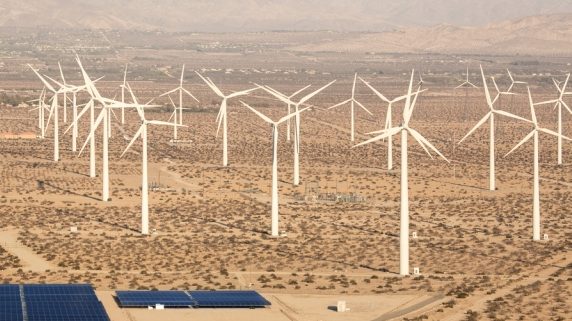Opinion
Lawmakers: Look closely at our energy landscape
 An aerial and solar energy installation in the southern California desert. (Photo: Veeterzy, via Shutterstock)
An aerial and solar energy installation in the southern California desert. (Photo: Veeterzy, via Shutterstock)The clean energy revolution is here, now, and California is a trailblazer of its success. Solar and wind power, electric vehicle use, rooftop photovoltaics, and community choice aggregation are all on the rise in California.
The traditional centralized, fossil-fuel power plants are now competing with renewable and distributed energy sources, forcing the industry and regulators to adapt, and upending close to one hundred years of power generation and distribution.
The critical question now is what impact this will have on the grid that keeps power flowing to every corner of our state, and how policymakers can balance the multitude of details required to maximize the promise of these technologies to the benefit of all stakeholders.
Transportation electrification, which is sorely needed to address the state’s increasing transportation emissions, actually won’t be a heavy lift of the power sector.
As with so many historic shifts, the devil is in the details.
Next 10’s new series of reports on issues facing the future of California’s grid aims to clarify the opportunities and trade-offs at hand to provide guidance to regulators and key decision makers. Take regionalization — creating a western regional grid that includes California, allowing power to be easily bought and sold across a wide swath of the country.
Regionalization is widely seen as the cheapest and surest way to ensure our state meets its climate and clean energy goals. But it raises complex issues, and has provoked a lot of debate. Next 10’s A Regional Power Market for the West: Risks and Benefits, authored by Bentham Paulos of PaulosAnalysis, seeks to cut through this debate to distill pros and cons.
Another report, Electric Vehicles and the California Grid, by Anand Gopal of Lawrence Berkeley National Laboratory, finds that transportation electrification, which is sorely needed to address the state’s increasing transportation emissions, actually won’t be a heavy lift of the power sector. Even with ambitious targets to dispatch five million zero emission vehicles on California’s roads by 2030, the electricity needed to power those vehicles only amounts of about 5 percent of the state’s current total electricity load.
What’s more, if the state implemented smart charging for these vehicles, they reduce curtailment, the turning off California’s solar resources during hot and sunny summer months, by as much as 50 percent. The paper finds that policymakers should focus their efforts on the local impacts increased electric vehicle adoption could have to the grid, by ensuring we build adequate charging and distribution infrastructure to support these vehicles.
Community choice aggregation (CCA) allows cities and counties to join together to purchase electricity on behalf of their residents and businesses.
Next 10’s report The Growth of Community Choice Aggregation: Impacts to California’s Grid, authored by a team of researchers at UCLA’s Luskin Center for Innovation, finds that if current growth trends continue, CCAs may serve a majority of California’s power consumers within the next 10 years, transforming California’s retail electricity sector.
While the study finds that CCAs have had a negligible impact on the grid to date, in the long-term, these CCAs can help minimize some grid issues.
Thanks to their public and local nature, they may be able to help reduce or shift energy consumption. By focusing on locally generated energy and demand-side measures, they will relieve stress on the grid. They are also offering consumers electricity with higher renewable energy content, compared to investor-owned utilities (IOUs).
At the same time, the ratio of renewable energy per IOU customer is increasing in part because IOUs hold a large number of long-term renewable energy contracts but are losing customers to CCAs.
Distributed energy resources (DERs), like rooftop solar, energy efficiency, and microgrids, are also changing the way electricity is produced and consumed around the state.
The Growth of Distributed Energy: Implications for California’s Grid, authored by Paulos, finds that DERs have grown substantially while costs have continued to fall and, while these resources can help make the grid more reliable, resilient, and equitable, they represent a shift from the traditional model of central energy resource control and ownership.
California is at the forefront of DERs – 90 percent of the nation’s small-scale energy storage is located here and nearly half of all U.S. large-scale storage is in California. The state has over 800,000 customers with rooftop solar systems, a number that’s set to grow with solar becoming mandatory on new homes in California after 2020.
As DERs continue to proliferate around the state, it will be critical that policymakers work to properly recognize and reward the value of DERs to ensure better coordination on the grid.
Together, these areas paint a picture of a rapidly changing energy landscape across California. The decisions legislators, regulators, and utilities make about the grid can position California for success in the clean energy economy, while slashing carbon emissions and curbing climate change. Keeping that vision of the future firmly in mind will help them make the right decisions today.
––
Ed’s Note: F. Noel Perry is a businessman and founder of Next 10, a nonprofit nonpartisan organization that educates, engages and empowers Californians to improve the state’s future
Want to see more stories like this? Sign up for The Roundup, the free daily newsletter about California politics from the editors of Capitol Weekly. Stay up to date on the news you need to know.
Sign up below, then look for a confirmation email in your inbox.

Leave a Reply